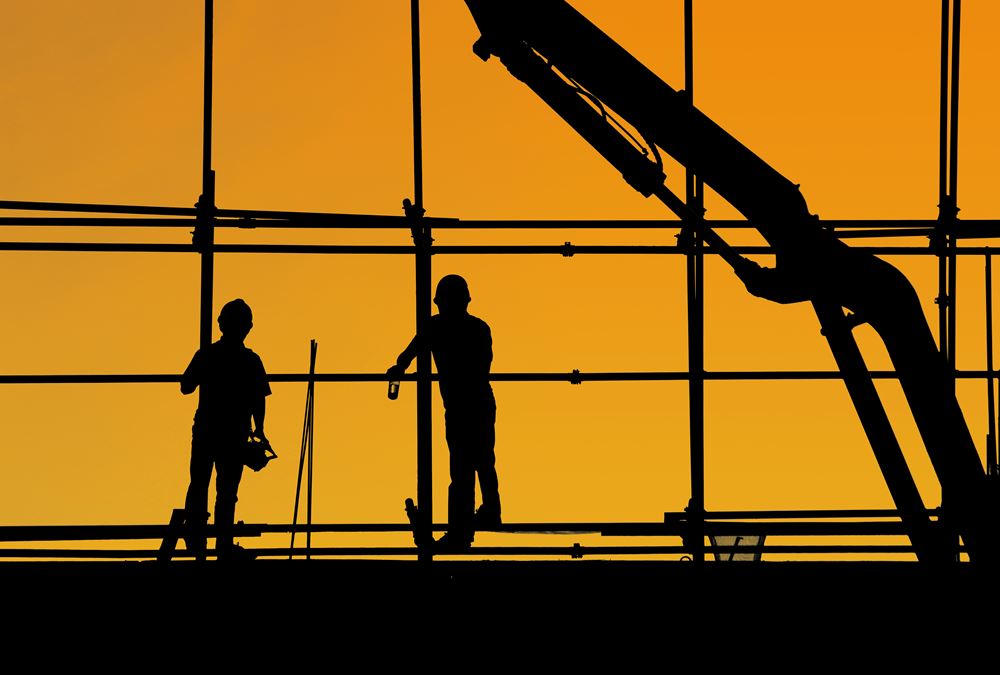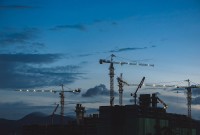- Home
- Business Processes
- Industry Knowledge
- Aerospace Industry
- Automotive Industry
- Banking Domain
- BFSI Industry
- Consumer/ FMCG Industry
- Chemicals Industry
- Engineering & Construction
- Energy Industry
- Education Domain
- Finance Domain
- Hospitality Domain
- Healthcare Industry
- Insurance Domain
- Retail Industry
- Travel and Tourism Domain
- Telecom Industry
- Leadership Skills
- eLearning
- Home
- Domain Knowledge
- Engineering & Construction
- Features of Construction Industry
Features of Construction Industry
Construction projects (activities) have some unique features with respect to other industrial projects. The construction industry is a unique industry with its own inherent complications that involves multiple stakeholders and agencies. Dependent on contractors and seasonal labor-force it has multiple linkages with other industries. Productivity and safety hazards are peculiar to this industry.
Some of the important features have been dealt with within this article.
1. Complexity
The conventional image of construction is an amalgamation of a series of manual and semi-manual activities. This concept is highly misleading. Construction projects, today, are high-tech, highly mechanized, and complex. A typical construction project is characterized by the consumption of numerous types of materials, variety of tools, equipment, plants and machinery working in tandem, several different contracting agencies, big and small, sub-contractors, petty contractors, vendors and suppliers, area specialists, consultants, supervisors and managers, each with independent organizational setups, participating with complex interactions, working in cooperation, sometimes even at cross purposes. In addition to this highly interactive and complex environment at a construction site, thousands of activities each of different nature are arranged simultaneously, many of them, sequentially or at random. Thus, the construction project today is much more complex than any other production process, manufacturing, or service industry.
2. Uniqueness
Construction is basically different from other industries. One important characteristic of this difference is its "one-off"' nature. Each construction project is a "unique" project, vastly different in nature and type from each other. For example, if two identical bridges are to be constructed at two different sites, the site characteristic and soil and sub-soil properties will introduce many variations, so ns to make each project very much different from the other.
It is now universally realized that each construction project is UNIQUE. Problems at one site are entirely different from any other site. This "One-off characteristic of construction project coupled with large changes in working climate, conditions, and environment, different technology levels and multiplicity of input resources makes it virtually impossible to examine what would have happened if an alternative decision was taken. Like life, construction does not permit any second chance to improve upon. This makes optimal utilization of resources at the construction sites n highly complicated exercise.
Hence, the level and quality of supervision have to be of a very high order on the construction site. A very efficient and fast management information system is essential to be installed at a construction project site. Any small deviation in basic parameters of time, cost, and quality is required to be detected almost instantly as it occurs and communicated to concerning decision makers almost instantaneously so that corrective measures can be undertaken before it is too late. The response period is very short on a construction project. Any bureaucratic procedure will be self-defeating.
3. Mobility of Facilities
In the product, process, and manufacturing industries, the work environment, and value-adding facilities are stationary. Hence, the work environment and facility layout can be optimally designed, provided, and controlled. The raw material in the form of a job moves from one facility to another adding value at each stage of operation.
On the contrary, on a construction site, the product is stationary, while the value is added at each stage of operation by moving the faculty from one construction stage to another; from place to place, from site to site, and from level to level, all these operations are undertaken under different uncontrolled environmental conditions. The temperature, visibility, humidity, air current speed, and other climatic parameters are constantly changing on a minute to minute basis. Most of the time, the work is to be carried out from a highly unsatisfactory condition of partially completed unfinished structures and temporarily assembled, hazardous working platforms. For both horizontal and vertical movements of input materials, human resources, equipment, etc., the conditions are continuously changing.
Thus, managerial techniques developed and perfected for other industries cannot as such be used on construction sites. This is required to be modified or new techniques developed to satisfy the constraints of construction sites.
4. Multiplicity of Agencies
Another typical characteristic of the construction industry is the presence of multiple regulatory agencies controlling the constructional site. Every one of these regulatory agencies is independent of others and often working at crossheads. Many Government, and Seri-government agencies like Municipal Committees, Corporations, Area Development Authorities, Urban and Rural Planning, and Development Agencies, Town and Country Planning Boards, Mining Department, Forest Department, Safety Inspectors, Fire Department, Labour Department, Director of Industries, local Police and Administration, Sales Tax, Income Tax and Excise Department, various other Public Departments and a similar never-ending plethora of controlling authorities required to issuing clearance certificates, controlling various aspects of construction at each project site.
5. Ad-hoc Labour Force
The bulk of the labor force engaged in construction is seasonal and migratory employed on a piece-rate basis. They are primarily committed to agriculture giving precedence to it over everything else during certain periods and climatic conditions in a year. During the rest of the year, they are engaged as construction labor for intermittent short durations; Very often the family is the unit of employment. They do not consider their involvement in construction as a vocation and thus have a commitment to the profession and have little aptitude and motivation to assimilate and improve upon the required knowledge and skill of the chosen trade. The piece-rate as the mode of payment also encourages the workers to put long hours of work and take large risks at the cost of health and safety, Workforce lives near the worksite where the adequate provision of sanitary facilities and housing are not provided as a rule rather than exception in-spite of contract provisions in the stipulated rules and labor laws. There is no availability of medical facilities, insurance, and pension/provident fund benefits, In general, the employment pattern and working conditions are drastically different and primitive in construction as compared with other industries.
6. Conglomerate of Contractors
A typical large construction project will have a prime contractor or a group of prime contractors, who bid for the work and secure it. Then, this conglomerate of prime contractors, select several subcontractors, far different work packages. A subcontractor, in turn, will engage his own group of minor and petty contractors and vendors for various work elements, activities, jobs, and trades. Thus, on a typical construction project site, there will be a network of thousands of contracting farms, carrying out contractual activities in a time-bound framework. The short term employment with job tenure lasting only for the period of particular contract duration and piece-rate payments are the main features of construction contracts. Management and labor relations are also contractual in nature and last only for the period of contract duration.
7. Stakeholders in Construction Work
In general, there are three groups of stakeholders involved in a construction project, each group contributing a specific component, namely the owner group, the engineering group, and the construction group.
(a) The owner group supplies the "need" of the project and the finances required to fulfill this need.
(b) The engineering group consists of area experts like architects, structural designers, and construction managers. These area experts supply the specifications, method statements, designs, and schedules of the project and perform supervision and quality control functions.
(c) The construction group consists of a matrix of contractors executing the various work packages.
8. Complex Inter-Relationships & Interactions
Many types of businesses are related to all three sectors of construction, residential, non-residential, and engineering. For example, surveying companies are required for all three types of projects. Architectural and engineering firms are also needed for any type of construction project. Additional companies directly involved in construction (aside from construction companies themselves) include inspection service companies, project management firms, and companies that specialize in creating models of large construction projects. Other companies associated with the industry include those that provide plumbing, heating, central air-conditioning, electrical wiring, lighting equipment, elevators, and escalators.
The interrelationship between these stakeholders is contractual in nature. Thus, there is no supreme authority at the construction project site over all the interacting stakeholders, There are only relative power and dependence between different contracting organizations, Construction is, therefore, a typical example of complex inter-organizational interactions. It involves several participating organizations, both direct and indirect, which influence the overall quality and productivity at the site, yet are not responsible or answerable to anyone. Each particular organization views the project from its own narrow and specific perspective. The owner would emphasize strict financial control to achieve optimum quality with the least expenditure. 'The priority of construction manager would be the strict adherence to cost, time and quality schedules, architect's main concern will be on aesthetics and beauty while a structural designer will stress on safety, simplicity, and constructability, The construction contractor will like to push up his output and productivity even compromising with quality and safety at the site. Thus, at each interfacing between different stakeholders at a construction site is a potential conflict-prone area, These complete and conflicting interactions of so many different and independent organizations will have a far-reaching and profound influence on the quality, productivity, and work environment at a construction project site.
9. Lack of Organizational Setup
The existing organizational setup in most of the construction organizations both in the public, government, and private sectors are not designed to manage such a highly interdependent and conflict-prone environment at the construction project.
We can conclude that the construction industry with all its uncertainties, high risks, and complexities, will always remain the most demanding on construction organizations. It is a challenging as well as hazardous profession, It is an unforgiving enterprise demanding highly creative and innovative human resource with experience, sometimes acquired at a great cost, It is highly unsatisfying to note that it is regarded with suspicion by most of the government departments and public at large, who fail to appreciate the large degree of uncertainties involved in the highly risky and competitive environment.
10. Safety Hazards
The construction, at the project site, is highly accident-prone. The accident rate in the construction industry is at least four times higher than that in any other industry. The construction consists of work executed from temporary structures and semi-finished stages, e.g. scaffoldings, staging, and falsework attached to and supported by permanent structures that are at various stages of erection and completion. The progress of the execution of these operations is continuously transforming the machinery and equipment (facility) layout and working environment. None of the safety precautions and safeguards adopted in permanent and "long-term" factories can be applied to construction sites. The working environment at these construction sites (temporary factories) is much more hazardous and straining due to the rapidly changing character of work sites, uncertainties of the natural environment, and fluctuating levels of beat, light, and sound. This is in complete contrast with the working conditions and controlled environment of manufacturing and other industries.
According to a survey in Ontario, Canada, the loss due to accidents in a particular year to the construction industry in Canada was more than the total profit of all the contractors in Canada in that year. It is, therefore, imperative that a safe environment and hence, the safety precautions and safeguards must be very carefully and exhaustively studied, researched, and strictly enforced at the construction sites. Enough is not done in this area either by concerned government departments or by larger firms in the construction industry.
11. Labour Quality
The basic necessity of work quality is the quality of its human resource, particularly at the operative level. Labor productivity is largely dependent on the quality of the labor force available in a given geographical area. Widely scattered and varied construction projects undertaken by a construction firm make it necessary to employ the local labor to a very large extent barring some very specialized trades. Workers, thus, follow the availability of job opportunities in the area and constantly change their employment.
Their loyalty and commitment are more towards their local/community leader and labor contractor as compared to their actual employer.
Another important aspect of labor quality in construction is ‘learning by doing, the process of training, and acquirement of skills. The different methods of doing the same work and different methods of achieving the same goal are learned either by imitation or trial and error techniques at actual construction sites. One's perceptions of work methodology are changed, modified, reinforced, or defined by subsequent experiences. The pooling of knowledge and skill of a group of persons (gang) can provide more choices and options in problems at sites. Thus, in the absence of any rational and organized apprentice training and skill formation program, the quality of construction, labor force available in an area will be isolated to the local level of work activity in a particular trade.
The major cause of poor quality and productivity in the construction sector is the scarcity of skilled manpower. As said earlier, it is much easier to find contractors in our country than to find a good mason or concreter. This is primarily due to the total absence of apprentice training programs in construction-related trades.
12. Productivity
The productivity of the construction industry is at a very low level as compared to other industries. Statistics show that in the decade of the 70s, the increase in construction productivity was a minimum of at0.8% as compared to 5.4% for public utilities, 4.6% for transportation, and 24% of all industries taken s an average. Several reasons can be assigned to the cause of low productivity in the construction sector; Haber and Levinson in their study have categorized them into the following two broad categories :
(a) Supply characteristics, and
(b) Demand characteristics.
The supply characteristic includes the immobility of construction projects, less than optimal working conditions, and the diversity of products. On the demand side, the construction industry is subjected to heavy fluctuations in demand (seasonal and cyclic). But the single most important reason for low productivity is the scarcity of trained and skilled human resources at a level of management from CEO to operatives.
The need for a better level of technology and practice, systematic planning and work programming, and effective management is therefore self-evident. Higher quality human resource is needed far wide-ranging aspects to be taken into account, e.g. site investigation, market survey, bidding for works, mode of construction, supervision, and control of man, material, equipment, and finance, monitoring the progress of execution, providing necessary controls of time, cost and quality, designing, implementing and maintaining an effective management information system from conceptualization to completion of the project end its subsequent maintenance during the stipulated period, settlement oaf contractual obligations and disputes and the realization of outstanding dues, These problems are magnified many times in recently introduced new concepts of contracting, e.g. OT, BOOT and BOO in the infrastructure sector.
The system productivity of the construction industry can thus be considered as a complex interaction of the following three productivity factors:
(a) Planning,
(b) Designing, and
(c) Performance(execution}.
The system management can thus be looked upon as a process of coordinating and communicating the entire project process of feasibility, design, planning, scheduling, contracting, executing, and controlling with the objects of maximizing system productivity (e.g. minimizing cost and duration).
Related Links
You May Also Like
-
Roles in Construction Industry
In general, there are various groups of stakeholders involved in a construction project. Each group contributing a specific component, examples are the owner group, the engineering group, and the construction group. In this article, we take a look at different roles that exist within the ambit of the construction industry.
-
Construction Industry – The Sectors
The construction industry produces a wide range of products, and the enterprises working in the construction domain are equally diverse. The construction industry can be divided into three sectors of construction namely building, infrastructure, and industrial. They can be further classified as residential, non-residential, and engineering projects. The construction activity can be carried out as a private or public endeavor.
-
Construction Industry – Business Model
The business model for the construction industry tells the story about how the industry works, defining who the target customers are, how the business makes money, and what the customer values. Most of the construction projects originate by clients as concepts of public or private utility, and actually delivered by many players in the industry.
-
Construction Industry in India
India is one of the world's fastest-growing construction markets, rising at the rate of 7-8 percent annually. By 2025, India will become the third-largest market in the world, thereby becoming a key driver for the Indian economy. The Indian construction industry employs over 30 million people and creates assets worth over ₹ 200 billion. Indian Construction Industry consists of 200 firms in the corporate sector.
-
Features of Construction Industry
Construction projects (activities) have some unique features with respect to other industrial projects. The construction industry is a unique industry with its own inherent complications that involves multiple stakeholders and agencies. Dependent on contractors and seasonal labor-force it has multiple linkages with other industries. Productivity and safety hazards are peculiar to this industry.
-
Importance of Construction Industry
The construction industry is an important part of the country's economy. Construction is an important sector that contributes greatly to the economic growth of a nation. The construction industry has laid down the physical and technological foundations upon which modern civilization has developed. It also creates investment opportunities across various related sectors and vital to the achievement of national socio-economic objectives.
-
Challenges in Construction Industry
In spite of the steady rise of the construction industry and its demand, it remains heavily dependent on manual labor. The construction industry faces challenges that become even more for developing countries. Some key challenges are poor productivity, inflation, and rising costs, availability of skilled labor and increased competition, and shrinking profit margins.
-
Overview of Construction Industry
Construction is the oldest and one of the largest industries in the world with its market size of about ten trillion US dollars. Construction is traditionally a contracting business right from the good old days, the industry comprises of a very large number of small firms. Now the construction industry is one of the largest industries in any economy. It makes a significant contribution to the national economy and provides employment to a large number of people.
Explore Our Free Training Articles or
Sign Up to Start With Our eLearning Courses

About Us
Learning
© 2023 TechnoFunc, All Rights Reserved








